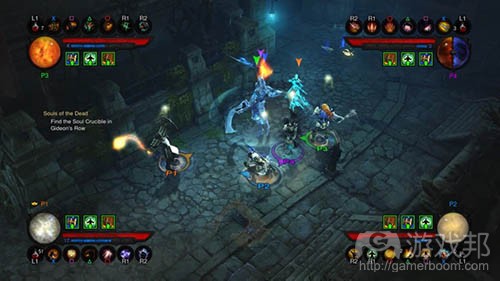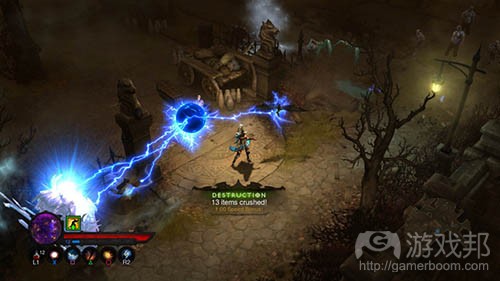《暗黑破坏神III》主设谈暴雪游戏设计理念
作者:Christian Nutt
暴雪如何维持其游戏质量?答案就是拒绝妥协,以及理解“硬核”与“休闲”并没有不可违逆的界线,而是一个范围的两端。
这就是《暗黑破坏神III:终极邪恶版》首席主机游戏设计师Jonny Ebbert和联合制作人Tiffany Wat的回答。这款游戏即将登陆PlayStation 4和Xbox One,它自原版两年前在PC平台发布以来已经过了一系列调整(以及一个完整扩展版本)。
定义,扩展和指导用户
作为开发者,没有什么比了解目标用户是谁这一点更重要和更困难了。对于暴雪而言,这并不是简单地将其划分为“硬核”或“休闲”群体——而是创造许多人想玩的游戏。
而且还要让用户基础进一步扩大,用Ebbert的话说就是:“总是尽量让游戏足够简单便于掌握。如果一款游戏具有足够的吸引力,人们真的为之所迷就会去学习极为复杂的东西。”
他补充表示,“生活亦是如此,对于每项活动只要你总是从最简单的开始,你练习得越多,就可以掌握越复杂的东西。”
Wat指出暴雪的工作就是“提供富有吸引力的内容来缩小人们之前的鸿沟。那么这是否就意味着休闲和硬核玩家群体之间存在明显区别?”现实一点来说,事实并非如此,它们当然存在一个中间状态。“
实际小,《魔兽世界》商业模式就是将新手转变为硬核能力的一个机器。Ebbert笑称,“我看到不少曾经极少玩游戏的人,就从新手级别转向了甚至我自己都觉得很困难的高手级别。”
Wat对此表示,“容易上手,难以精通一直就是暴雪的一个口头禅。”
至于《暗黑破坏神III》,“你很快就能理解游戏,至少知道自己应该在其中做些什么。”但该游戏面向硬核玩家乃至从未玩过游戏的休闲用户提供了一种“适用于所有人的定制体验”。
据Ebbert所述,游戏开发者那种“为1英尺的步骤50英尺的斜坡”的倾向可能会很不利,“有时候你必须让玩家遇到一些阻力,这是你必须不断衡量的东西。”
Ebbert描述了最近的一次内部会议的情况:“我们引进了一项功能并表示,‘玩家究竟会如何理解呢?’”有名开发者对此回顾了自己曾经只是为了玩游戏而重新配置电脑BIOS的经历。Ebbert称“我们可不想这么麻烦,但玩家都很聪明,你要相信他们。“
身为暴雪所承受的“压力”
Ebbert称暴雪的声誉也为大家带来了“不堪承受的压力”,“我们有极高的标准,因为我们的粉丝也有很高的标准。”
该公司是以一种“真正悲观主义的心态”来开发主机版《暗黑破坏神III》(Ebbert称这对于暴雪来说“家常便饭”),“我们认为它会非常困难 ,也的确如此。我们在暴雪通常会做好最糟糕的打算。我想当时我们一开始是想,‘它可能并不可行’。当我们越是深入其中时就越能够感到其中的可实现性。”
Wat称“我们并不想让它成为一个移植版本。我们要关注每个层面。如果你只是一个刚接触这款游戏的新玩家,应该获得什么感觉呢?如果有什么感觉不对劲,我们就必须修正它。”
即使是对暴雪游戏不甚熟悉的主机玩家也清楚这家公司的名誉,尽管后者是在PC平台发家,《暗黑破坏神III》在主机上也必须令人感觉良好,方不辜负它在质量上的盛名。
移植意味着彻底检查它的控制系统(从间接到直接的角色操控)和摄像机系统,以及修复其技能系统。Ebbert表示,“同一款游戏会因其输入方式的不同而产生截然不同的预期。控制器是最主要的区别。”
维持暴雪质量
开发主机版本的团队成员并非原版《暗黑破坏神III》团队开发者,有数位成员拥有主机经验——Ebbert认为这有助于他们解决问题,“我们拥有新鲜的视角,能够从新玩家角度来看待游戏。”
这一点很重要,因为坦率地在暴雪内部分享反馈是实现其高质量标准的关键,“实际上,内部玩法测试最残酷,如果你认为消息公告板很残酷,内部反馈甚至还比这更残酷。我们对自己的工作要求非常严格。”
Wat表示,“如果你给予诚实的反馈——如果你在执行测试时真的没有想过游戏体验很有趣,以诚实的态度给予反馈对我们才是最有益的。如果我们不能向同行坦白自己的游戏体验情况,这才会对我们造成损害。”
尽管她承认反馈也可能具有主观性,“但最重要的是,游戏是体验,所以如果你不分享自己的个人体验,我们就无法制作出质量上乘的游戏。”
Ebbert称在接手一个项目时,“我们必须拥有合理的设计值,公司已经公开宣传了自己的核心价值,它经常依据这些价值来判断游戏。我们就是通过这些过滤器来审视团队反馈。”
“在每个项目尾声,我们都会做一个事后回顾并评估自己的游戏。我们将审视这些价值。我们对自己相当严格。我们并不只是给自己好评。”
《暗黑破坏神》于2000年出世。暴雪并不只是根据自己的创意准则,而是根据怀旧感来评估这款游戏——这款游戏并非人们之前玩过的版本,而是存活在人们脑海中的游戏。
Ebbert承认“这是一个极高的标准。我们的价值也在不断发展。”
暴雪在前进道路上还会回头审视自己的旧版游戏,但并不会执拗于这些旧版本的做法。Ebbert称“旧版游戏就好像我们过去价值的一个时间胶囊。”
有时候开发者会意识到这一点:“唯一的出路就是根据公司当前的价值来评估一款游戏,并由此向前推进。”(本文为游戏邦/gamerboom.com编译,拒绝任何不保留版权的转载,如需转载请联系:游戏邦)
How Blizzard makes games like Diablo III
By Christian Nutt
How does Blizzard maintain its game quality? By refusing to compromise and by understanding that “core” and “casual” are not hard-and-fast distinctions, but two ends of a spectrum.
That’s according to Jonny Ebbert and Tiffany Wat, lead console designer and associate producer for Diablo III: Reaper of Souls – Ultimate Evil Edition. The game is soon to come out on PlayStation 4 and Xbox One, and has gone through a number of refinements (and a full expansion) since its original release on PC a couple of years ago.
Defining, expanding, and teaching the audience
As a developer, there’s arguably nothing more important than figuring out who your audience is, and possibly nothing more challenging. For Blizzard, it’s not about slicing it into segments like “core” or “casual” — it’s about creating games that lots of people want to play.
It’s also about allowing that audience room to grow: “Always try to make it as simple to learn as possible,” says Ebbert. “If a game is compelling enough, people will learn crazy complicated things, if they’re that engaged.”
“Always try to make it as simple to learn as possible. If a game is compelling enough, people will learn crazy complicated things, if they’re that engaged.”
“If you breadcrumb it properly, that’s just how life works,” he adds. “You always start off very simple, and the more you practice, you can get more complex — in every activity.”
Blizzard’s job is “about providing compelling things to bridge that gap, to bring people across,” Wat says. So that underlying assumption about there being distinct casual and core game audiences? “Realistically, it’s just not true,” says Wat. “There’s definitely an in-between.”
That is, in fact, World of Warcraft’s business model: It’s a machine to turn newbies into hardcore raiders. “People who’ve hardly played games, I’ve seen them go from the newbie UI where you have just one button to push to the raid UI where even I look at it [and say], ‘Aah! I can’t do that!’” laughs Ebbert.
“‘Easy to learn, difficult to master’ is a mantra at blizzard, constantly,” Wat says.
As for Diablo III, “You can figure it out pretty quickly, at least get an idea of what you’re supposed to do,” she says. But the game offers “a tailored experience for everyone” from hardcore min-maxers to someone who’s never played games at all.
“Sometimes you need to let the players encounter some resistance… Players are smart. You need to trust them a little bit.”
According to Ebbert, the tendency of game developers “to build a 50-foot ramp for a one-foot step” can actually get in the way. “Sometimes you need to let the players encounter some resistance,” Ebbert says. “It’s something you need to constantly gauge.”
Ebbert recounted a recent internal meeting: “We’d introduce a feature and say, ‘Well how would a player ever figure that out?’” One developer, he said, went on a rant about how he used to reconfigure his computer’s BIOS just to play games. “We don’t want to go that far, but players are smart,” says Ebbert. “You need to trust them a little bit.”
The ‘incredible pressure’ of being Blizzard
The Blizzard name brings “incredible amounts of pressure” with it, says Ebbert. “We have really high standards because our fans have really high standards.”
(There’s also the commercial expectations: before the new console version of the game ships, Diablo III and its expansion have already sold 20 million copies — without China.)
The company went into development of the console versions of Diablo III with “a really pessimistic eye” (“usual” for Blizzard, says Ebbert). “We went in expecting it to be very difficult, and it was. We tend to prepare for the worst at Blizzard. I think when we were first going in we thought, ‘This might not even work.’ And the more we were just diving in the more achievable it started to feel.”
“We tend to prepare for the worst at Blizzard.”
“We didn’t want it to be a port. We looked at every aspect. If you were just a brand-new player picking up this game, how should it feel? If anything didn’t feel right, we had to fix it,” Wat says.
Even console players who might not have a lot of direct experience with Blizzard’s games are aware of its reputation; though it started off on PCs, Diablo III had to feel right on a console, while living up to that quality bar.
Porting meant complete overhauls to its control (a move from indirect to direct character manipulation) and camera systems, as well as revamp to its skill systems. “The same game has different expectations based on the input,” Ebbert says. “The controller makes it a different game.”
Maintaining Blizzard quality
The team who worked on the console edition came from outside the original Diablo III team, and had several developers with console experience — something Ebbert says helped them “cheat a little bit” in figuring all this out.
“We had fresh eyes, and fresh perspectives, and we were kind of able to look at it from the eyes of a new player.”
“If you think message boards can be brutal, internal feedback can be even more brutal.”
That’s important, because candidly sharing feedback inside Blizzard is key to meeting its high quality bar. “Actually, internal playtests are the most brutal. Sometimes — if you think message boards can be brutal, internal feedback can be even more brutal,” Ebbert says, laughing. “We’re very hard on our own work.”
“If you’re giving honest feedback — if you truly don’t think a game experience is fun when you’re doing a playtest — it is in all our best interests to be honest about that,” Wat says. “We would do ourselves a disservice if we’re not being honest to our peers about what the game experience is like.”
While she acknowledges that feedback can be subjective, “at the end of the day, games are experiences, so if you’re not sharing what your personal experience is, then we’re not doing our job to make the best quality games,” says Wat.
When approaching a project, “we have to have the proper design values,” Ebbert says. The company has widely publicized its core values, and it judges its games against them regularly. “When we go through the team feedback we’re kind of running it through those filters,” says Ebbert.
And then, “at the end of every project we will do a postmortem and we will rate our own game. We’ll go through the values. We’re pretty hard on ourselves; we’re not just giving ourselves straight As,” Ebbert says.
Diablo II came out in 2000, however. The company is not just being judged against its creative principles, but against nostalgia — the version of the game not that people played but which lives on in their heads and hearts.
“It’s a very high bar,” Ebbert admits. It’s also a moving target: “Our values are constantly evolving.”
The company will take a look at its older games when paving its path forward, but it can’t slavishly stick to them. An older game is “like a time capsule of what our values were back then,” he says.
And sometimes, the developers reach a realization like this one: “by today’s standards, that wouldn’t fly. Games have become too refined.” The only way through is to judge a game against the company’s current values and move forward from there.(source:gamasutra)
上一篇:关于游戏中被隐藏起来的秘密










































